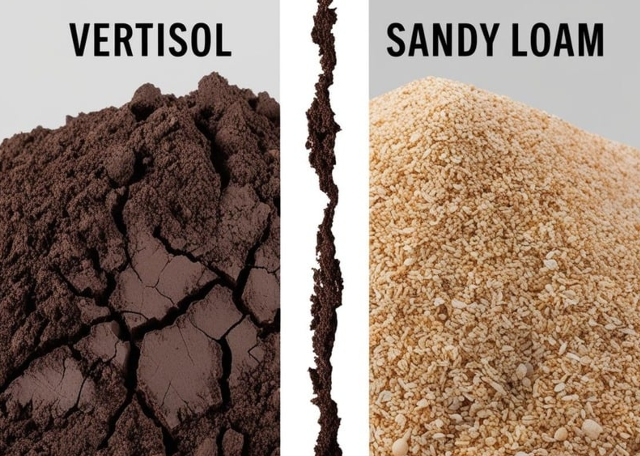Gardening on the Edge:. How Soil Shapes the Way We Grow


Every garden tells a story, and at its heart is the soil. It’s the foundation of everything we grow, yet no two soils—or the gardens they inspire—are the same. Imagine two wildly different worlds: arid landscapes with vertisol and subtropical regions with sandy loam or loamy clay. Their challenges and opportunities are as different as night and day, yet both offer unique beauty and bounty to the adventurous gardener.
Let’s dig deep into these contrasting soils and discover what it means to garden where the ground beneath your feet shapes every decision you make.
Arid Vertisol: The Soil of Extremes
Vertisols are dramatic. Found in semi-arid climates, these heavy, clay-rich soils are infamous for their cracking during dry spells and swelling when wet. They are tough, unpredictable, and fascinating.
Key Features:
Water Behaviour: Vertisols are moisture hoarders, soaking up rain and swelling like a sponge. Yet, they shrink and crack during drought, creating deep fissures that challenge roots.
Drainage: Poor. Water often pools, making it difficult for delicate roots to breathe.
Fertility: High in nutrients, but locked up tight—plants must work hard to access them.
Gardening Tips for Vertisol:
Plants to Choose: Hardy, drought-tolerant species like native acacias, saltbush, and deep-rooted trees that can withstand cracking soil.
Watering Strategy: Deep, infrequent watering helps plants establish and adapt to the feast-or-famine nature of this soil.
Soil Management: Use organic matter like mulch and compost to improve structure, reduce cracking, and increase water retention. Raised beds or mounded rows can combat poor drainage.
Gardening in vertisol is a labour of love, but the rewards—resilient plants and a uniquely textured landscape—are worth the effort.
Subtropical Sandy Loam or Loamy Clay: A Gardener’s Dream
In subtropical climates, sandy loam and loamy clay present an entirely different canvas. These soils are forgiving, fertile, and full of promise, but they still have quirks to navigate.
Key Features:
Water Behaviour: Sandy loam drains beautifully but can dry out quickly, while loamy clay holds moisture without waterlogging.
Drainage: Excellent for sandy loam; moderate for loamy clay, which needs careful management to avoid compaction.
Fertility: High, with nutrients readily available for plant roots.
Gardening Tips for Loamy Soils:
Plants to Choose: Everything from lush ornamentals like ferns and palms to fruiting trees like citrus and mangoes thrive in these soils.
Watering Strategy: Regular, even watering keeps plants thriving without risking over-saturation.
Soil Management: Sandy loam benefits from organic matter to improve water retention, while loamy clay needs aeration and organic amendments to maintain its structure.
With a subtropical soil palette, the possibilities are endless, offering a lush, productive garden with a little care and attention.
Cracked Clay vs Fertile Loam: A Gardener’s Dilemma
Feature Arid/Vertisol Subtropical/Loamy Soils Climate Dry, low rainfall (400-600mm annually) Moist, high rainfall (600-1200mm annually) Drainage Poor, prone to waterlogging Excellent to moderate Fertility Nutrient-rich but hard to access Nutrient-rich and easily accessible Best Plants Drought-tolerant natives and hardy trees Fruit trees, ornamentals, vegetables Watering Needs Deep, infrequent watering Regular, even watering Key Challenges Cracking, poor aeration Risk of compaction in loamy clay
What Does This Mean for Your Garden?
If you’re transitioning from an arid, vertisol-based garden to a subtropical paradise—or vice versa—you’re embarking on a grand gardening adventure. Here’s what to consider:
Plants to Bring or Leave Behind: Hardy plants like succulents, saltbush, and wattles may not thrive in the moisture-rich subtropics. Similarly, lush subtropical favourites like ferns or mangoes might struggle in the tough, nutrient-locked vertisols.
Soil Prep: Each soil demands specific amendments. Organic matter is a universal ally, but how you use it varies—loosen compacted loamy clay or enrich sandy loam.
New Plant Explorations: In the subtropics, dive into vibrant, water-loving species. In arid climates, look for drought-proof pioneers like native grasses or hardy shrubs that laugh in the face of drought.
Soil: The Artist Behind Your Garden Canvas
The infographic you see isn’t just a comparison—it’s a story of two worlds. Whether you’re planting in cracked, arid vertisol or lush, loamy clay, your soil shapes the way you connect with your garden. By embracing its quirks and demands, you unlock the potential for growth, resilience, and beauty in any climate.
Which soil is calling to you? Let’s celebrate the landscapes beneath our feet and the gardens they inspire.
